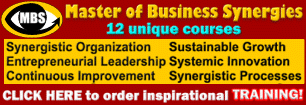|
To Lead in Volatile Times You Must: |
-
learn to stay ahead of the volatility curve and its inherent dangers
-
learn to manage rapid upturns as well as downturns
-
learn to
anticipate and prepare for volatility
-
distinguish patterns and order amidst chaos
|
|
Ten
Volatility Leadership Best Practices
Managing
the Challenges of a Volatile and Chaotic Economy |
-
Make hast slowly: Leadership
intelligence is more important than ever -
move with greater speed and precision
than ever before, but take time to think.
-
Partner with customers: Now, more
than ever, customer satisfaction and retention are critical to
success. You must
partner with your customers,
reconnect with them to create a shared future that is more secure than
either could have built alone.
-
Build a culture of commitment: Build
and preserve a culture of commitment, one where employees passionately
pursue your organization's
cause and
mission.
Strengthen your culture by providing
strategic
alignment, creating a shared sense of purpose and aligning
rewards and
incentives appropriately.
-
Put the right person, in the right place,
right now: Create a high-performing
team with a wide range of talents -
assemble and align the right collection of talent to face the
challenges that lie ahead. Invest your human capital to maximize
individual, team and organizational success.
-
Maximize knowledge assets: In the
new
economy, your organization's ability to
harness and maximize knowledge plays
the dominant role in creating
competitive advantage. You must learn
to identify, mobilize, and create knowledge assets to boost the value
of your organization's intellectual capital.
-
Cut costs, not value: While
managing costs, don't cut the muscle along with the fat. Progress
means
moving resources from low-value to high-value
uses. Reduce expenses while protecting and enhancing the
value of your business.
-
Outposition your competitors:
Build and leverage your organization's
unique competitive dimensions - in a
rapidly changing and increasingly competitive business environment,
success goes to those who can understand and develop sources of
distinctive competitive advantage.
-
Stir, don't shake: Manage stress
without loosing your competitive edge - reduce anxiety and inspire
hope by stirring employees to higher levels of achievement, not
shaking them with fear and negativity.
-
Cut through the noise: Get your
message through the "noise" that rises in tandem with volatility and
chaos - without the ability to
communicate effectively, a leader's
other skills are worthless.
-
Focus or fail: Stay focused and on
track - follow a carefully structured process that would focus your
energies while highlighting and prioritizing high-leverage
opportunities for success.
|
|
Why Volatility Leadership?
We are living if the
new economy characterized by rapid unpredictable change and volatility.
Volatility and chaos aren't bad or good - they are just realities. While
associated with strife, hardship, and discontent, volatility and chaos are
also synonyms for fundamental change, breakthroughs, discoveries, and
optimist. "In this new world, leaders must
anticipate,
rush to think, reach out, build enduring bonds with customers and
stakeholders, and get comfortable with leading at the edge of chaos."1
To guide your organization through volatile times, you must learn how to see
the patterns in chaos and take charge, learn how to act boldly to safeguard
your organization and lead it to a brighter future, and to alter your
strategies to prepare for whatever the world may bring next.
Ten Volatility Leadership
Best Practices
The below ten critical elements provide a process of
stabilization that will help you harvest the benefits of the rapid change
brought about by the volatile times, reduce the risk of volatility and the
likelihood of crisis:
-
Make hast slowly
-
Partner with customers
-
Build a culture of commitment
-
Put the right person, in the right place, right now
-
Maximize
knowledge assets
-
Cut costs, not value
-
Outposition your competitors
-
Stir, don't shake
-
Cut through the noise
-
Focus, or fail
"While the individual strategies provide proven solutions to
specific challenges, their greatest value lies in the integrated protocol
for leadership created by their fusion - a whole greater than the sum of its
parts."1


|



